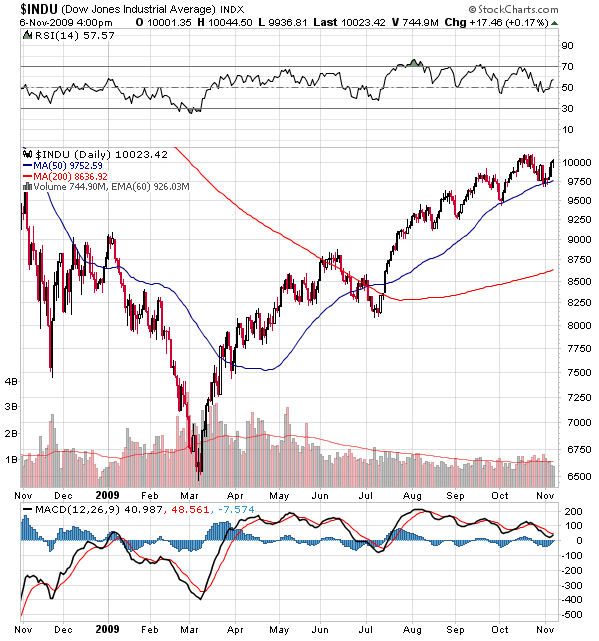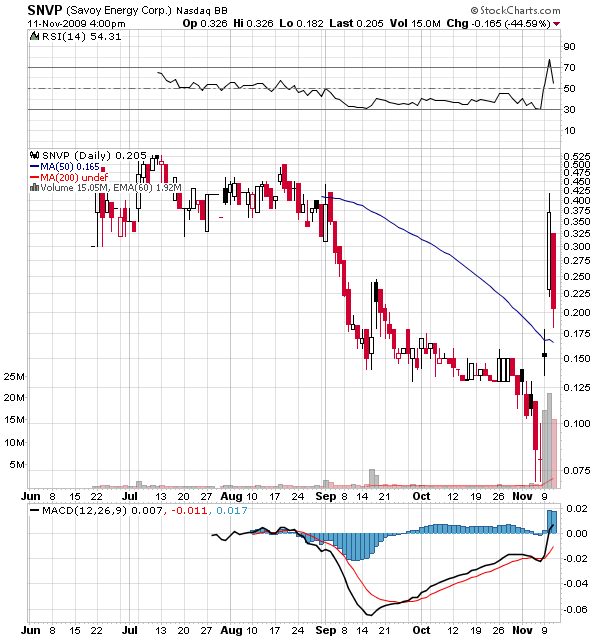
HOT TOPICS LIST
- Strategies
- Stocks
- Buy
- Investing
- Brokers
- Psychology
- Interviews
- Accumulate
- Sell
- Hold
- Spotlight
- Websites
- Candlestick Corner
- Gold & Metals
- Options Trading
LIST OF TOPICS
TRADER'S NOTEBOOK
Planning For 2010
12/17/09 03:15:44 PM PSTby Michael Porter
The worst economic downturn of the 20th century has soured the attitudes of many Americans in regards to investing. Following the collapse of Lehman Brothers and the long painful decline of the Dow Jones Industrial Average to 6,600, many investors stopped investing, stopped trusting in the reliability of our retirement plans, and stopped buying as many groceries. It was a scary time. For the remainder of 2009, however, we have seen an extraordinary recovery. It’s time to stop seeing this recession as a reason to cut our losses and recognize it as an unprecedented opportunity to turn a profit. It’s time to plan for 2010.
| A lot of investors will get spooked around the end of January 2010. Why? Because they will most likely see a decline in the market. Unemployment is still at an all-time high. We are still seeing weaker consumer sales data. The financial sector is still a mess, with many banks still dependent on government funds to keep afloat. It wouldn't surprise me to see a decline back down to Dow Jones Industrial Average (DJIA) 9000 again in the first half of 2010. There will be a lot of anxiety, with many investors fearing a second economic collapse. What the smart investor needs to do is look for the new bottom of this market, and raise cash. This will not be a time to panic and sell. It will be the time to do our research, plan carefully, and buy quality stocks at a significant discount. The market does well in November and December about 85% of the time. Many analysts declared we had seen the market’s high mark for the year when we broke Dow 10,000 in October (Figure 1). Yet recently in November 2009, we broke Dow 10,226. Investors shook off the effect of an unemployment rate of 10.2% and decided to risk their money anyway in a weak economy. For many investors, this strategy continues to pay off. It's the basics of investing: Buy low and sell high.
FIGURE 1: THE DOW JONES INDUSTRIAL AVERAGE. The DJIA’s sharp decline in the first half of 2009 has rebounded in the second half of the year. |
| WHAT TO LOOK FOR This is where planning for 2010 becomes vital. Recently, I was asked an interesting question about the market. I was asked if it was better to have a weak dollar with inflation in the economy and a strong stock market, or a strong dollar to combat inflation and a weaker stock market. I had to give that one some thought. As an investor, you must recognize what is inevitable in our current economic situation. The government will not be able to pour extra funds into the economy indefinitely. The Federal Reserve will not be able to keep interest rates at their current low levels forever, nor ignore the fact that the value of the dollar is significantly diminishing. Eventually, the Fed will raise interest rates by a large degree. The government will collect its stimulus funds from banks. Taxes will go up to cover the unprecedented deficit the government is running up. All of this will have a negative effect on the market. This process will start in 2010. However, we can rest easy. The sky is not falling for a second time. You will also see many optimistic signs for the market in 2010. Starting in the second and third earnings quarters, many of the struggling companies that will survive this crisis will start posting positive earnings. Next summer, we might see the stock market take off like a rocket. Even with the Fed raising interest rates, we will see a continued increase in the gross domestic product (GDP) and a lower unemployment rate. By the end of 2010, we could see major improvements in the economy. This is the start of a new bull market, and an extraordinary opportunity for profit. |
| So as a new investor, what do you focus on? Where is the safest, most profitable place for you to put your cash? It depends on how much time you are willing to put into research, and how much confidence you have in your financial savvy. Many professional money managers will try to convince you that you are not intelligent enough to run your own investments. Most of the time this is not the case. If you’re willing to put the time into checking up on your stocks, you can maximize your profits. As a serious working investor, you definitely want to max out your IRA each year. You want to make smart decisions about your 401K plan if you have that option. Don’t let the company you work for make the decision for you haphazardly. Do your research and pick the best funds available for you. Mutual funds are always a good option for the casual investor. Keep in mind that they tend to underperform in the long run, compared to individual stocks. If you want to maximize your profits, you’ll do your research and invest in stocks. WHAT TO INVEST IN |
| If you’re not comfortable investing in stocks, there are a lot of other investment options for you in the coming year. Those of you preparing for retirement are looking for the absolute safest bets for profit. Again, you won’t go wrong doing your research and investing in a highly rated mutual fund. Or you could lend Uncle Sam some cash by buying US Treasury securities. Treasury bills mature anywhere from four to 52 weeks and are very safe. Most banks now offer money market accounts with higher returns on your deposited funds. There are many safe options for investing in this turbulent market. ON THE OTHER HAND Let me present an example. Savoy Energy Corp. (SNVP) traded for months at around 16 cents a share (Figure 2). It recently surged on unusual volume to 41 cents a share before settling to 20 cents a share. So if you invested $5,000 in this company at just the right time and sold at just the right time, you more than doubled your investment within the time frame of a few days. Something like a penny stock can seem very tempting, but keep in mind that you can just as easily lose most of your $5,000 if you’re not careful. Always set limit sell orders on the stocks and don’t get greedy.
FIGURE 2: HIGH-RISK PLAYERS. SNVP’s short climb to $0.40 per share is typical of penny stocks. |
| Don’t let the troubled economy keep you out of investing. Things are getting better. Smart investing is far too important to your future and the security of your family to be ignored. Tailor your personal investment strategy based on the amount of time you’re willing to commit and the amount of risk you are willing to assume.
SUGGESTED READING |
Michael Porter, a teacher, has worked in the Virginia Beach school system for three years. He has a bachelor's degree in history from Virginia Wesleyan College.
PRINT THIS ARTICLE

|

Request Information From Our Sponsors
- StockCharts.com, Inc.
- Candle Patterns
- Candlestick Charting Explained
- Intermarket Technical Analysis
- John Murphy on Chart Analysis
- John Murphy's Chart Pattern Recognition
- John Murphy's Market Message
- MurphyExplainsMarketAnalysis-Intermarket Analysis
- MurphyExplainsMarketAnalysis-Visual Analysis
- StockCharts.com
- Technical Analysis of the Financial Markets
- The Visual Investor
- VectorVest, Inc.
- Executive Premier Workshop
- One-Day Options Course
- OptionsPro
- Retirement Income Workshop
- Sure-Fire Trading Systems (VectorVest, Inc.)
- Trading as a Business Workshop
- VectorVest 7 EOD
- VectorVest 7 RealTime/IntraDay
- VectorVest AutoTester
- VectorVest Educational Services
- VectorVest OnLine
- VectorVest Options Analyzer
- VectorVest ProGraphics v6.0
- VectorVest ProTrader 7
- VectorVest RealTime Derby Tool
- VectorVest Simulator
- VectorVest Variator
- VectorVest Watchdog


